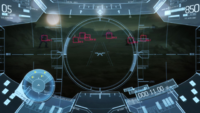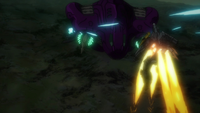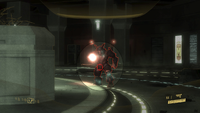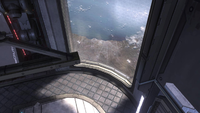Archive:Halo Waypoint/2009 to 2014/Universe/Technology: Difference between revisions
From Halopedia, the Halo wiki
(→VISR) |
|||
| Line 75: | Line 75: | ||
===Space Tether=== | ===Space Tether=== | ||
{{Article Quote|Test...}} | {{Article Quote|Test...}} | ||
Over two and a half centuries before the war with the Covenant, humankind began construction on the Earth's first orbital space elevator at the coastal city of New Mombasa. It was the first of six such elevators spread across the planet's surface. The orbital space elevator eventually became a common, affordable means of extra-atmospheric conveyance, allowing the UNSC and private corporate entities the ability to ferry large amounts of material and personnel into space at comparatively low costs. | |||
Commonly referred to as "space tethers," the orbital space elevators vary in size and shape, but they are all typically composed of the same raw material. Meshed together as a complex composite of intertwining nano-fibers, these ingredients form a series of massive cords and rings several hundred meters wide. They bind to a grounded set of anchors larger than most buildings which hold the elevator’s structure in place while the Earth spins on its axis. The zenith of the elevator, commonly known as the "orbital" or "terminus," is then pulled taut by the Earth's rotational inertia, sliding into geosynchronous orbit thousands of kilometers above the planet. | |||
While Earth has six space elevators, many planets found within the Outer Colonies have more since there is a heavy human reliance on the production and shipment of agricultural and mineral goods from remote worlds. Prior to the Covenant's invasion, the farming colony of Harvest, for example, had seven elevators, while some mineral-rich worlds had as many as nine. | |||
Of Earth's six elevators, only four remained intact at the end of the 2552 CE. On October 20, 2552, an incident known as the New Mombasa Slipspace Event severed the city's space elevator, spreading its shattered remnants across East Africa. Only weeks later, a separate event—in Havana, Cuba on November 3, 2552—resulted in the destruction of what was known as the Centennial Orbital Elevator. | |||
<gallery> | <gallery> | ||
File:Old HW ST 1.png|Foundation - Reinforced mount holds the tether securely | |||
File:Space tether.png|Tether - The tether stretches thousands of kilometers | |||
File:Old HW ST 2.png|Remains - New Mombasa's tether strewn across the savanna | |||
File:Old HW ST 3.png|Orbital - An empty bay within an orbital station | |||
File:Old HW ST 4.png|View - High above Quito, Ecuador | |||
File:Old HW ST 5.png|Communications - A series of consoles monitor the tether | |||
</gallery> | </gallery> | ||
*'''Source''': | *'''Source''': [http://halo.xbox.com/en-us/intel/theuniverse/locations/gallery/space-tether/e9b2f438-9b5b-477e-8e52-d4e6801e9d5b '''Halo Waypoint''': ''Space Tether''] (defunct, backup on [https://web.archive.org/web/20111007185941/http://halo.xbox.com/en-us/intel/theuniverse/locations/gallery/space-tether/e9b2f438-9b5b-477e-8e52-d4e6801e9d5b Archive.org]) | ||
===Modular Dispersal Technology=== | ===Modular Dispersal Technology=== | ||
Revision as of 05:35, March 12, 2017
| The following is a verbatim transcription of an official document for archival reasons. As the original content is transcribed word-for-word, any possible discrepancies and/or errors are included. |
Technology
Reach: Implements of War
- Main article: Reach: Implements of War
The UNSC Army has outfitted its soldiers with the best equipment possible, and when that isn't available deep behind enemy lines, they can pry the Covenant's arsenal from the aliens' cold, dead hands.
- Video link: Reach: Implements of War
The Covenant on Reach
- Main article: The Covenant on Reach
The Covenant is a broad and expansive empire of races, governed by a singular military goal: the recovery of Forerunner artifacts. Although the arrival of the Covenant at a human planet - and the bloodbath that always followed - has become almost routine to mankind, the aliens' discovery of Reach is both shocking and ominous. Reach, the UNSC's key military stronghold, is the last line of defense against the Covenant's merciless march of destruction towards humanity's homeworld: Earth.
- Video link: The Covenant On Reach
Prototype
Under the direction of Vice Admiral Danforth Whitcomb, the Office of Naval Intelligence created a number of classified codename projects during the early-to-mid 26th century, including the more publicly-known SPARTAN-II and MJOLNIR programs. Another such program—known simultaneously as HRUNTING and YGGDRASIL—was a nuclear-powered armor defense system which could be operated by a standard UNSC Marine.
Unlike the more compact armor variant of MJOLNIR, HRUNTING/YGGDRASIL’s results would not require extensive and risky biological augmentations for the operator and, as a result, would be much more expensive to design and manufacture. Very few have reported seeing this technology in the field since it remained in a somewhat secretive state well into the war with the Covenant—at least one suit is known to have been deployed in-combat before reportedly being scuppered by ONI as a security precaution.
HRUNTING/YGGDRASIL’s mechanical defense systems and weaponry capabilities are expansive—far outstripping MJOLNIR in almost every way save for bio-ergonomic mobility and size. Although its full technical specifications were never made public, reports have indicated the following components were equipped:
- HRUNTING/YGGDRASIL Mark I Prototype Exoskeleton based on titanium alloy plating and nanocomposite titanium microfiber
- Dynamic Local Dissipative Shield Technology
- T261 Lucifer AMGG (Arm-Mounted Gatling Gun) with 20mm high-explosive rounds, alternate-hand grip stabilizer
- Type-18 Magnetic/Bayonet-style Claymore which can be primed, attached, or otherwise impaled into nonmagnetic surfaces
- Motion Sensor with 1400m+ range (within map mode) across flat surfaces with minimal obstruction
- 2 x Ventral VTOL Stabilizers / 2 x Dorsal VTOL Stabilizer / 4 x Afterburner Thrusters
- LAU-181D/SGM-151 Shoulder-mounted, self-guided high-explosive missiles
- M149 Magellan RCL–armor mounted recoilless rifle with 105mm high-explosive ordnance
Another rumored component was a 300 MT lead-tampered nuclear fission self-destruct sequence (in compliance with Cole Protocol and Winter Contingencies) which would re-use the fusion components of the suit’s power system and begin with a staggered countdown and could only be completed by delivery of a voice command code word—the exact word never having been publicly revealed. This method hints strongly at a kamikaze-style purpose rather than simple security. Since this is illegal under several intact conventions, its official status remains “security.”
- Source: Halo Waypoint: Prototype (defunct, backup on Archive.org)
VISR
When Project: MJOLNIR launched, ONI was forced to mitigate the substantial losses it incurred during the development and real-world production of its armor technology. Because of MJOLNIR’s embedded fusion reactors, each suit of armor costs significantly more than any other comparative item within the ONI's Special Operations budget—estimated to be somewhere near the cost of a standard warship.
For this reason, the UNSC was committed to the widespread application of a variety of individual technologies derived directly from MJOLNIR, specifically for functional use within the military. The Visual Intelligence System Reconnaissance Class, or VISR, is one of these, now used by a wide spectrum of Special Operations personnel. Unlike the variant used by SPARTAN-II super-soldiers, there is no neural interface prerequisite to the VISR. Despite this, it operates in a very similar manner to the heads-up display incorporated into the Mark V and Mark VI suites of MJOLNIR software.
At its core, VISR is a standard HUD that offers real-time tactical information about the wearer's health, ammunition count, and mission objectives. In addition to this, VISR can store a considerable amount of data for later review, including custom mission intel, navigational layouts, and audio files to assist the user operating behind enemy lines. The most obvious alteration to the existing MJOLNIR version, however, is the ability to view in low-light mode, highlighting allies, enemies, and points of interest with a brightly lit wire silhouette.
- Source: Halo Waypoint: VISR (defunct, backup on Archive.org)
Space Tether
Over two and a half centuries before the war with the Covenant, humankind began construction on the Earth's first orbital space elevator at the coastal city of New Mombasa. It was the first of six such elevators spread across the planet's surface. The orbital space elevator eventually became a common, affordable means of extra-atmospheric conveyance, allowing the UNSC and private corporate entities the ability to ferry large amounts of material and personnel into space at comparatively low costs.
Commonly referred to as "space tethers," the orbital space elevators vary in size and shape, but they are all typically composed of the same raw material. Meshed together as a complex composite of intertwining nano-fibers, these ingredients form a series of massive cords and rings several hundred meters wide. They bind to a grounded set of anchors larger than most buildings which hold the elevator’s structure in place while the Earth spins on its axis. The zenith of the elevator, commonly known as the "orbital" or "terminus," is then pulled taut by the Earth's rotational inertia, sliding into geosynchronous orbit thousands of kilometers above the planet.
While Earth has six space elevators, many planets found within the Outer Colonies have more since there is a heavy human reliance on the production and shipment of agricultural and mineral goods from remote worlds. Prior to the Covenant's invasion, the farming colony of Harvest, for example, had seven elevators, while some mineral-rich worlds had as many as nine.
Of Earth's six elevators, only four remained intact at the end of the 2552 CE. On October 20, 2552, an incident known as the New Mombasa Slipspace Event severed the city's space elevator, spreading its shattered remnants across East Africa. Only weeks later, a separate event—in Havana, Cuba on November 3, 2552—resulted in the destruction of what was known as the Centennial Orbital Elevator.
- Source: Halo Waypoint: Space Tether (defunct, backup on Archive.org)
Modular Dispersal Technology
- Source:
Booster Frame
- Source:
Gauss Technology
- Source:
Drop Pod
- Source:
The MJOLNIR Project
- Main article: The MJOLNIR Project














